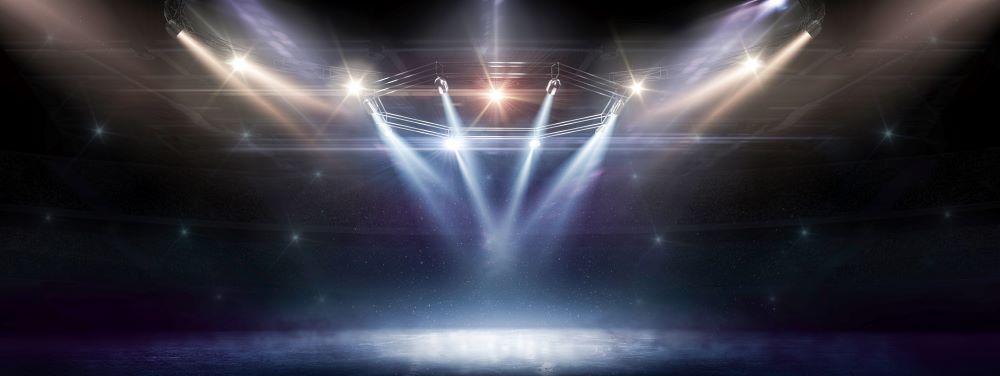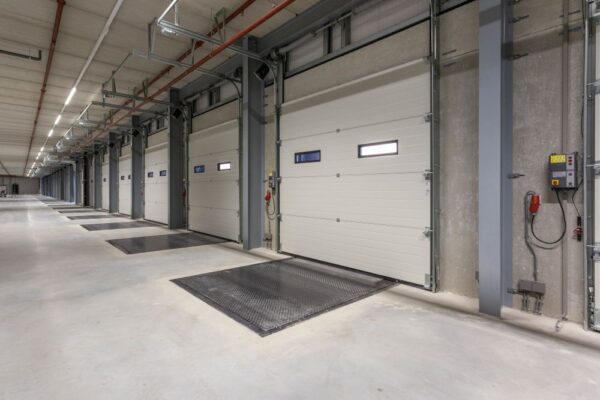The Cincinnati Reds defeated the Philadelphia Phillies in the first lighted nighttime major league baseball game on May 24, 1935. More than fifty years later, the Chicago Cubs hosted their first-ever nighttime game under newly-installed lights at Wrigley Field on August 8, 1988. The next revolution in lighting sports arenas will not be as dramatic, but it is nonetheless beginning to build with the transition to LED lighting systems in both indoor and outdoor sports venues.
Sporting events at both the amateur and professional level rely on good lighting to enable athletes to see the action happening around them and to maintain visual contact with a ball or puck that can be moving faster than 100 miles per hour. Daytime lighting under cloudless conditions are ideal, but those conditions are never guaranteed, and are simply inapplicable for indoor arenas. Supplemental outdoor lighting and strong indoor lighting are necessary to expand the availability of those venues and to improve conditions for optimal sports play. Athletes have become accustomed to the limitations of traditional high-pressure sodium and carbon arc lights. New LED lighting systems are removing those limitations and improving both the viewing and playing potential in arenas that have switched to LED systems.
New LED Sports Lighting Technology
Lighting has always been a critical component of sports, from ancient coliseums to modern stadiums. In recent years, Light Emitting Diodes (LEDs), with their impressive durability, energy efficiency, and versatility, have transformed the landscape of sports and stadium lighting. This article delves into the world of LED sports lighting, exploring its advantages, the current state of LED lighting technology, and the top LED lighting solutions available for stadiums and sports venues today.
The Importance of Lighting in Sports
Lighting plays an integral role in the realm of sports. For athletes, good lighting is essential to optimize performance and prevent injury. For spectators, both at the venue and watching broadcasts, excellent illumination enhances the viewing experience by providing clear, well-lit views of the action. Furthermore, adequate lighting is pivotal to ensuring the safety of everyone present in the stadium, from players and officials to fans and staff.
Understanding LED Sports Lighting
LED lights work by passing an electrical current through a semiconductor material, causing it to emit light. Unlike traditional incandescent and fluorescent lighting, LEDs produce minimal heat and convert a higher proportion of energy into light. This operational efficiency, combined with a highly directional light output and a long lifespan, makes LED lighting an excellent fit for sports venues.
LED sports lighting systems are designed to provide high-quality illumination for stadiums and sports arenas. These lighting systems offer several advantages over traditional lighting technologies, making them an ideal choice for sporting events. Here’s a closer look at how LED sports lighting works and its specific benefits for stadiums:
- Efficiency and Energy Savings:
LED lights are known for their exceptional energy efficiency. They convert a larger percentage of electrical energy into visible light, minimizing energy waste and reducing operating costs. This efficiency translates to significant energy savings compared to traditional lighting options. In stadiums, where large amounts of lighting are required, LED sports lighting can substantially reduce electricity consumption, resulting in lower utility bills and a reduced environmental impact.
- Directional and Uniform Lighting:
LED sports lighting fixtures have a highly directional light output, allowing for precise light distribution. This characteristic enables lighting designers to effectively illuminate specific areas of the sports field, reducing light spillage and ensuring optimal visibility for players and spectators. With proper placement and beam angle adjustments, LED lights can deliver uniform lighting across the entire playing area, eliminating shadows and hotspots.
- Enhanced Visibility and Color Rendering:
In sports, visibility is crucial for players and spectators alike. LED sports lighting provides excellent visibility with high color rendering capabilities. LED lights accurately reproduce colors, enabling players to distinguish different hues and enhancing their performance on the field. Additionally, spectators can experience a more vibrant and immersive viewing experience, as LED lights offer superior color fidelity and clarity.
- Instant On/Off and Dimming Capabilities:
LED sports lighting systems offer instant on/off functionality, eliminating the warm-up time required by traditional lighting sources. This quick response time allows for immediate illumination when needed, enhancing the overall game experience. Furthermore, LED lights can be easily dimmed to adjust the lighting levels according to specific requirements, providing flexibility for different events or times of day.
- Long Lifespan and Low Maintenance:
LED sports lighting fixtures have an exceptionally long lifespan, typically ranging from 50,000 to 100,000 hours or more. This longevity significantly reduces maintenance efforts and costs associated with frequent bulb replacements. Stadiums can benefit from extended periods of reliable lighting, minimizing downtime and ensuring uninterrupted sporting events. Moreover, LED lights are durable and resistant to vibrations, making them suitable for the demanding conditions of sports environments.
- Sustainability and Environmental Impact:
LED sports lighting aligns with sustainability goals, as it promotes energy efficiency and reduces carbon emissions. By consuming less energy, LED lights contribute to the conservation of natural resources and help mitigate the environmental impact associated with conventional lighting technologies. Additionally, LED lights do not contain hazardous materials like mercury, making them safer for both the environment and human health.
LED sports lighting systems offer numerous advantages for stadiums, delivering efficient, high-quality illumination that enhances visibility, reduces energy consumption, and lowers maintenance costs. The directional light output, excellent color rendering, and long lifespan of LED lights make them an ideal choice for sports venues, ensuring optimal performance and unforgettable experiences for athletes and spectators alike. By embracing LED sports lighting, stadiums can enjoy the benefits of superior lighting while promoting sustainability and contributing to a greener future.
Advantages of LED Sports Lighting
LED sports lighting comes with numerous advantages. They are significantly more energy-efficient than traditional lighting solutions, providing substantial savings on electricity costs and contributing to more sustainable sports practices. LED lights also deliver superior visibility, with uniform, bright light that reduces shadows and enhances the playability for athletes and the viewing experience for spectators.
Moreover, LED lights have an extended lifespan, requiring less frequent replacements and reducing maintenance costs. Perhaps one of their most notable benefits is their instant on/off and light control capabilities. These features enable dynamic lighting effects for events, contributing to a more immersive and entertaining sports atmosphere.
The Current State of LED Lighting Technology
LED lighting technology continues to advance at a rapid pace. High-luminosity LEDs, intelligent lighting systems, and smart controls are some of the recent developments that are revolutionizing the sports lighting landscape. Several sports stadiums around the globe have already adopted LED sports lighting. For instance, the Levi’s Stadium in California, home to the San Francisco 49ers, is known for its state-of-the-art LED lighting system that enhances energy efficiency while delivering high-quality illumination.
LED Lighting Solutions for Stadiums and Sports Venues
Choosing the right LED lighting solution for a sports venue involves several considerations. Aspects such as brightness, color rendering, and glare control are critical to ensure excellent visibility and minimize visual discomfort.
There are various types of LED sports lighting fixtures available, including floodlights for broad illumination and spotlights for focused lighting. Each has its own set of advantages and can be chosen based on the specific requirements of the venue.
Top LED Sports Lighting Brands and Product Recommendations
These top LED sports lighting brands have proven their expertise and innovation in the field, providing reliable and efficient lighting solutions for sports facilities worldwide. Let’s explore their products and the unique features they offer:
Philips:
Philips is a renowned brand that has been at the forefront of lighting technology for decades. Their ArenaVision LED floodlighting system is specifically designed to meet the demanding requirements of sports stadiums and arenas. It provides high-quality lighting with excellent color rendering, ensuring optimal visibility for players and spectators alike. The system offers dynamic and programmable lighting options, allowing for customizable lighting effects and seamless integration with entertainment events. Philips’ commitment to energy efficiency and sustainability is evident in their LED sports lighting solutions, which deliver significant energy savings compared to traditional lighting technologies.
Cree:
Cree is another prominent player in the LED lighting industry, known for its commitment to producing high-performance lighting solutions. Their Edge High Output LED fixtures are ideal for large sports venues, delivering exceptional light output and efficiency. With their advanced optics and superior thermal management, Cree’s LED fixtures offer uniform illumination, minimizing shadows and ensuring excellent visibility on the playing field. These fixtures are designed to provide consistent lighting performance while reducing energy consumption, making them a reliable choice for sports lighting projects.
Musco Lighting:
Musco Lighting is a leading provider of sports lighting solutions, recognized for its innovative TLC for LED™ system. This system combines Musco’s expertise in lighting design with advanced LED technology to deliver precise light control and energy efficiency. Musco’s TLC for LED™ system features proprietary optics that maximize light distribution and minimize glare, ensuring uniform illumination across the sports field. The system also incorporates intelligent controls for enhanced energy management, allowing facility managers to optimize lighting levels based on specific requirements. Musco’s commitment to quality and reliability is exemplified by their comprehensive warranty and maintenance program, which ensures long-term performance and customer satisfaction.
LED Sports Lighting Product Recommendations
While the above-mentioned brands are leaders in LED sports lighting, it’s important to consider specific project requirements and consult with lighting professionals for tailored recommendations. Here are a few notable product recommendations from these brands:
- Philips ArenaVision LED Floodlighting: The ArenaVision LED range offers various models suitable for different stadium sizes and requirements. These floodlights provide powerful illumination, customizable lighting effects, and energy-efficient performance.
- Cree Edge High Output LED Fixtures: The Edge High Output series offers a range of fixtures designed for sports lighting applications. These fixtures provide high lumen output, excellent light quality, and precise optical control, ensuring optimal visibility and performance on sports fields.
- Musco Lighting TLC for LED™ System: The Total Light Control system from Musco Lighting combines LED technology with advanced optics and intelligent controls. It provides precise light distribution, reduced glare, and energy-efficient operation, enhancing the visibility and quality of sports lighting.
LED sports lighting has transformed the way we illuminate sports facilities, providing energy-efficient, high-quality lighting solutions. Brands like Philips, Cree, and Musco Lighting have been instrumental in driving innovation in this field, offering cutting-edge LED lighting systems designed specifically for sports applications. Whether it’s dynamic floodlighting, high-output fixtures, or precise light control, these brands continue to push the boundaries of LED sports lighting technology, ensuring optimal performance and enhanced experiences for athletes and spectators alike.
Why Stadium are Making the Change to LED
LED sports lighting is transforming how we illuminate our games, delivering benefits that extend beyond merely lighting up a field or court. From enhancing energy efficiency and sustainability to
LED systems can be adjusted to provide that greater or lesser illumination that may be needed by specific sporting events. Sports like hockey and tennis that involve a fast and small object will need greater lighting, while football benefits from lower lighting levels. LED systems easily accommodate the demands of these individual sports through customizable control centers and versatile lighting fixtures.
Traditional sports lighting systems were often criticized for creating hotspots and other areas in a playing field where lighting variations required athletes to adjust their play to accommodate non-uniformities. LED lights eliminate these hotspots. LED sports systems, for example, creates optimum beam uniformity across playing surfaces with minimum glare that might interfere with an athlete’s performance.
Unlike traditional systems that might require elevated lighting poles and other light standards for mounting, LED systems give arena and stadium designers more options for mounting light fixtures in a mode that coordinates better with each playing field’s dimensions. Designers and architects can use lower-elevation light poles and multiple fixture configurations to achieve better lighting uniformity than had been previously provided by traditional fixtures.
Sports venue operators will also appreciate the better economics that LED systems create. LED lighting consumes substantially less electrical energy and requires far less maintenance than traditional lighting systems. The initial upfront costs of an LED lighting system are quickly recovered through reduced operating and maintenance costs, typically within the first few years of operations.








